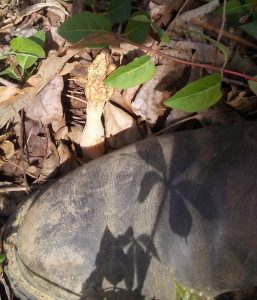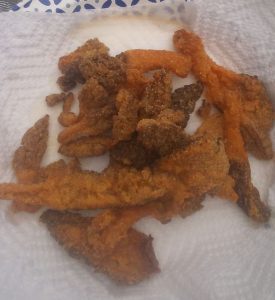By Daniel Mires
With spring approaching most hunters that I know are already preparing for the upcoming turkey season. But along with chasing longbeards there’s an added hunting season that many enjoy which you won’t find information about in your hunting regulations.
Yes, along with the thunder chicken, you can also look for the hickory chicken.
Depending on where you are located, it can also be known as the dryland fish, honeycomb mushrooms, or more commonly the morel mushrooms.
Granted some might not consider looking for mushrooms as hunting, but after you first try to locate them you will understand the comparison.
Normally morels like it when the temperature starts to get around 60 degrees and the nighttime temperatures are near 40 degrees.
 South facing slopes are typically where you will first find these delicious morsels. This is, of course, due to the South facing slopes and hillsides will get more sun and the ground will get warmer quicker than any other places.
South facing slopes are typically where you will first find these delicious morsels. This is, of course, due to the South facing slopes and hillsides will get more sun and the ground will get warmer quicker than any other places.
Another way looking for morels is indeed a type of hunting is that you need to be a woodsman to help your cause. One thing that will benefit you is if you can identify different types of trees, with or without their leaves.
Morels can be found many times very near the base of trees.
Historically, elm, ash, poplar and apple trees are some of the favorites of the morel to be near.
Also, dead or dying trees, as well as rotting logs are great places to key your eyesight in on.
Concentrate your search to areas with moist but not wet soil, specifically in or very near creek bottoms.
Another sometimes overlooked tip to finding morels is when the temperatures are right, the next day after a rain is a great time to make the most of your time afield looking.
This can also be a great way to spend the time in the turkey woods in between fly-down and when the gobblers leave their hens and begin searching for more girlfriends.
After you harvest a bag full of morels, you will definitely find this time more productive than just a nap under a tree.
You can cook morels several different ways, after cleaning, of course.
 First thing to remember is that morels are hollow. I recommend slicing longways to ensure it is hollow on top, differently than a “false morel” which are solid inside.
First thing to remember is that morels are hollow. I recommend slicing longways to ensure it is hollow on top, differently than a “false morel” which are solid inside.
Near the top of my list is to then coat with flour, or your favorite fish batter, and deep fry until they float. I believe they are best enjoyed right out of the grease.
Since turkey season and morel season go hand in hand, my all-time favorite way to enjoy both is in a batch of turkey alfredo.
I start with either one side or both sides of a turkey breast.
Season with a Cajun seasoning, my personal favorite is Tony Chachere’s.
Then grill until almost done but not quite. Slice the turkey breast into thin strips.
Cook a pot of fettuccine noodles and drain.
Add a jar, per side of turkey breast, of your favorite alfredo sauce, your turkey strips and finally the piece de resistance, your fresh, cleaned morel mushrooms.
Let simmer at about 350 degrees, stirring occasionally for about 30 minutes.
Rest assured after this meal you will definitely be glad you went morel hunting.



